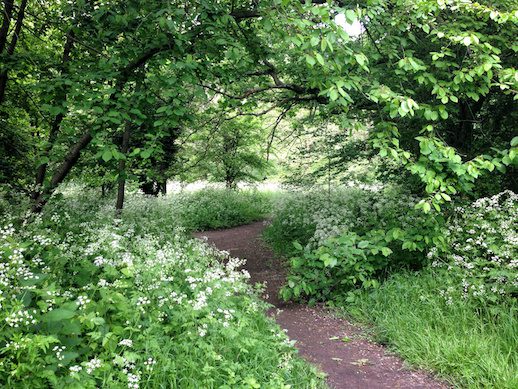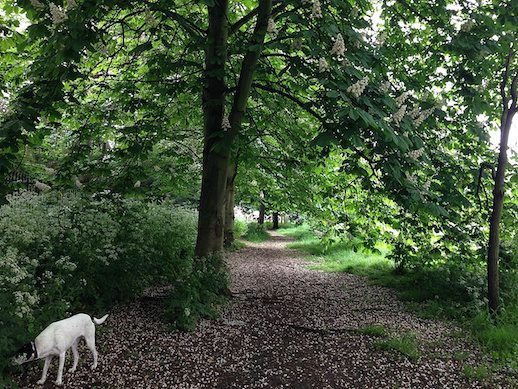Words & pictures by Melissa Harrison.
For year after barren, deskbound year, May’s lush cow parsley and riotous birdsong, horse chestnut candles and emerging butterflies passed me by. In fact, spring itself passed me by for much of my twenties – as did the seasons in general, and all the rhythms of the natural world. I remember one record-breaking summer only because the air conditioning in the building I was temping in broke down, and there’s a snowy winter I recall mainly due to the fact that the local buses stopped running; autumn was more about the new season’s clothes than anything else. This is what can happen when you live in London and spend five days a week in an office.
Cities are great places for nature: I know that now. Great swathes of the capital are far more alive than intensively farmed countryside – though farmland answers to our unsophisticated conviction that ‘nature’ equals green trees and grass. In a city, though, you need to seek the wild out and find a way to tune into it, rather than it being a kind of eternal stage-set that you can take for granted. In a city you can choose to separate yourself almost entirely from the seasons in a way that’s much harder if you live out of town.
I say ‘choose’, but this profound disconnection can feel more like the default setting if you have a nine-to-five job and not much money to get away at weekends. What turned life around for me was the perfect (albeit accidental) storm of lifestyle changes: renting a flat with a little garden in which I began tentatively to grow things; finding a way to work from home some of the time; getting a dog, Scout, and walking her daily; and learning how to take photos – which taught me how to see. I can barely remember my old, trammelled life now, only that it was far less rich, and far less meaningful. The city I lived in then, too, was hostile and exhausting and bleak.
* * *
This May the cow parsley has been spectacular. On my morning walks with Scout, on Tooting Common, I seek it out, taking shady trails through lacework jungles that run waist-high, shoulder-high, head-high. The smell of it leaves me dizzy and grinning, half-drunk on spring’s lush, green growth. Christ, I think, every May now when it flowers. I’ve been waiting for the cow parsley for so long.
The horse chestnuts, this year as ever, were the first of the Common’s trees to come into leaf, unfurling floppy, soft palms above the paths. They’re heavy with upright cream racemes pricked with a blood-red blush at the centre of each floret, proof that pollination has taken place. Because they’re so densely foliated the ground beneath the horse chestnuts is shady and dim, white-speckled by shed candle-flowers and strongly contrasted with the sunlit grass beyond; in their canopy the belligerent parakeets are invisible, if not inaudible, above.
Scout trots ahead. She’s used to me lingering: I stoop for empty beer bottles and crisp packets, stand and stare at the railway embankment where what I’m almost sure is a blackcap belts out its sudden notes. My bins hang on my shoulder; I can’t make out where the song comes from, I don’t know where to look, and eventually, defeated, move on. From further away comes the road-mending trill of a wren – two wrens; a few paces on a song thrush and a robin have set up shop and are belting out their contrasting wares. Greenfinches wheeze; a blackbird warbles distantly. Chaffinches bounce coins off the shafts of morning sun.
Here and there the grass is starting to set seed, although the unmown areas have still about a foot to put on before they’re tall enough for Scout to springbok through and for grasshoppers to set abuzz on hot summer days. I know which parts of the sward will grow high just as I know why some of the Common’s paths curve, having seen the obstacles joggers and dog-walkers threw a loop around: a fallen branch from two winters back, long since rotted away; a puddle, impassable in winter but almost dried out now. I could show you two fox dens, and where the winter redwings roost; I could point out where the jack-by-the-hedge does best, and which wall graffiti, currently absent, often decorates. I know where the Polish drinkers sit and reminisce; on which bench a homeless man sometimes sleeps; and which tucked-away corners of the woods host fast, urgent fucks up against the fence. Habit and observation have made this part of the Common as intelligible to me as my back garden was as a child, a place where multiple layers of meaning and memory collide. There is a deep and, I suspect, atavistic pleasure in that.
* * *
With Scout back on the lead I walk home through streets I used to think I might live on one day, and now know I never will. The elegant villas near the Common, swagged with wisteria, fetch close on a million, and even the cheapest flats have soared out of my reach. Every second house, it seems, is scaffolded or has a skip outside, and looking north and west there are cranes everywhere: scruffy Streatham, like the rest of the city, is being transformed. Caesars nightclub with its roman chariot horses – formerly the Locarno, England’s first ever purpose-built ballroom – has been demolished; only its frontage is left intact, behind which 43 luxury flats are going up. The site hoardings are emblazoned with the words ‘COMPLETE LIFESTYLE’; this means an underground garage, concierge, gym, and a ‘park’. An artist’s impression shows a square of sterile green inside the gated development’s tall walls: the plan is for symmetrical flowerbeds and ornamental cherries like pink lollipops.
On the six-lane High Road (pollution levels among the worst in London) I edge past a young man being restrained by police having smashed in the rear window of a car at the lights. Diners in the chic new brunch place, open to the pavement, gawp nervously: the area might be classed as ‘up and coming’ but this is too real, too south London, too close to the bone.
But on the Common the lush young grass under the sycamores is sticky with honeydew and damp down at its shady roots, where grasshopper nymphs pass through instar after instar on their way to adulthood. A breeze turns over a few scattered pin-feathers marking the place where a fox took a young wood pigeon just after dawn, trotting off towards the railway embankment with the squab clamped and staring in its jaws.
By the time I walk that way again tomorrow the bird’s barred feathers will all but one have blown away.
Summer: An Anthology for the Changing Seasons, edited by Melissa Harrison, is out now. Buy a copy here.

